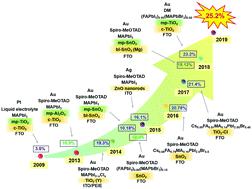当前位置:
X-MOL 学术
›
Mater. Horiz.
›
论文详情
Our official English website, www.x-mol.net, welcomes your feedback! (Note: you will need to create a separate account there.)
Advances in design engineering and merits of electron transporting layers in perovskite solar cells
Materials Horizons ( IF 13.3 ) Pub Date : 2020-06-22 , DOI: 10.1039/d0mh00586j Han Pan 1, 2, 3, 4, 5 , Xiaojuan Zhao 1, 2, 3, 4, 5 , Xiu Gong 1, 2, 3, 4, 5 , Hao Li 1, 2, 3, 4, 5 , Najib Haji Ladi 3, 4, 6, 7 , Xiao Li Zhang 7, 8, 9, 10, 11 , Wenchao Huang 12, 13, 14, 15, 16 , Shahzada Ahmad 17, 18, 19, 20, 21 , Liming Ding 7, 22, 23 , Yan Shen 1, 2, 3, 4, 5 , Mingkui Wang 1, 2, 3, 4, 5 , Yongqing Fu 3, 4, 6, 7, 24
Materials Horizons ( IF 13.3 ) Pub Date : 2020-06-22 , DOI: 10.1039/d0mh00586j Han Pan 1, 2, 3, 4, 5 , Xiaojuan Zhao 1, 2, 3, 4, 5 , Xiu Gong 1, 2, 3, 4, 5 , Hao Li 1, 2, 3, 4, 5 , Najib Haji Ladi 3, 4, 6, 7 , Xiao Li Zhang 7, 8, 9, 10, 11 , Wenchao Huang 12, 13, 14, 15, 16 , Shahzada Ahmad 17, 18, 19, 20, 21 , Liming Ding 7, 22, 23 , Yan Shen 1, 2, 3, 4, 5 , Mingkui Wang 1, 2, 3, 4, 5 , Yongqing Fu 3, 4, 6, 7, 24
Affiliation

|
The emerging photovoltaic technology, namely perovskite photovoltaics, follows a style to the blooming flower with superficial prosperity described by the ancient poet Yuxi Liu. Metal-halide perovskite has become one of the most promising photovoltaic materials for thin-film solar-cell applications, mainly due to its exellent visible light capture capability, large diffusion coefficients and long diffusion lengths of charge carriers (both electrons and holes). The reported power conversion efficiency of laboratory produced perovskite solar cells (PSCs) has exceeded 25%. However, this value was only achieved for devices of less than 0.1 cm2 dimensions, and decreases significantly with the increase in area (for example, down to 11.6% for a device area of ∼800 cm2, showing the issues with the scalability). In PSCs, the electron transport layer (ETL) has to perform two essential functions, which are related: (i) to collect and transfer charges after the injection of electrons from the perovskite light harvester; and (ii) to block the backflow of holes, thus realizing effective charge separation and suppressing charge carrier recombination. However, there are several critical issues associated with the ETLs which limit the further development of the PSCs. For example, the experimentally obtained open-circuit voltages in PSCs are typically much lower compared to the theoretical voltage limit with their optical bandgaps between 1.59 and 1.63 eV. This is mainly attributed to inefficient charge transport in the PSCs due to inhomogeneous charge accumulation and serious interfacial recombination at the interfaces between the ETL and the perovskite active layer. We scan recent developments of ETLs in PSCs, and discuss design methodologies, mechanisms, processing and characterization of new types of ETLs. High power conversion efficiency with large open-circuit voltages/photo-currents could be achieved through designing materials and microstructures for high-quality ETLs with a high electron mobility, high electrical conductivity and pinhole-free film morphology. It is crucial to balance the charge diffusion processes in the respective charge collective layers of PSCs as the interfaces between the ETLs and perovskites along with their interfacial structures play key roles in achieving new solid-state mesoscopic solar cells optimized open circuit voltages and output photocurrents.
中文翻译:

钙钛矿太阳能电池设计工程的进展和电子传输层的优点
新兴的光伏技术,即钙钛矿光伏技术,沿袭了古代诗人刘禹锡所描述的表面繁华的盛开花朵的风格。钙钛矿金属卤化物已成为薄膜太阳能电池应用中最有前途的光伏材料之一,这主要是由于其出色的可见光捕获能力,大的扩散系数和电荷载体(电子和空穴)的长扩散长度。实验室生产的钙钛矿太阳能电池(PSC)的报告功率转换效率已超过25%。但是,该值仅在尺寸小于0.1 cm 2的设备上才达到,并且随着面积的增加而显着降低(例如,对于约800 cm 2的设备面积下降到11.6%,显示可扩展性方面的问题)。在PSC中,电子传输层(ETL)必须执行两项基本功能,这些功能是相关的:(i)从钙钛矿集光器注入电子后收集和转移电荷;(ii)阻断空穴的回流,从而实现有效的电荷分离并抑制电荷载流子复合。但是,与ETL相关的几个关键问题限制了PSC的进一步发展。例如,PSC中实验获得的开路电压通常比理论电压限值低得多,它们的光学带隙在1.59和1.63 eV之间。这主要归因于由于不均匀的电荷积累和在ETL和钙钛矿活性层之间的界面处的严重界面复合,导致PSC中电荷传输效率低下。我们扫描了PSC中ETL的最新发展,并讨论了新型ETL的设计方法,机制,处理和特性。通过设计具有高电子迁移率,高电导率和无针孔膜形态的高质量ETL的材料和微结构,可以实现具有大开路电压/光电流的高功率转换效率。
更新日期:2020-06-22
中文翻译:

钙钛矿太阳能电池设计工程的进展和电子传输层的优点
新兴的光伏技术,即钙钛矿光伏技术,沿袭了古代诗人刘禹锡所描述的表面繁华的盛开花朵的风格。钙钛矿金属卤化物已成为薄膜太阳能电池应用中最有前途的光伏材料之一,这主要是由于其出色的可见光捕获能力,大的扩散系数和电荷载体(电子和空穴)的长扩散长度。实验室生产的钙钛矿太阳能电池(PSC)的报告功率转换效率已超过25%。但是,该值仅在尺寸小于0.1 cm 2的设备上才达到,并且随着面积的增加而显着降低(例如,对于约800 cm 2的设备面积下降到11.6%,显示可扩展性方面的问题)。在PSC中,电子传输层(ETL)必须执行两项基本功能,这些功能是相关的:(i)从钙钛矿集光器注入电子后收集和转移电荷;(ii)阻断空穴的回流,从而实现有效的电荷分离并抑制电荷载流子复合。但是,与ETL相关的几个关键问题限制了PSC的进一步发展。例如,PSC中实验获得的开路电压通常比理论电压限值低得多,它们的光学带隙在1.59和1.63 eV之间。这主要归因于由于不均匀的电荷积累和在ETL和钙钛矿活性层之间的界面处的严重界面复合,导致PSC中电荷传输效率低下。我们扫描了PSC中ETL的最新发展,并讨论了新型ETL的设计方法,机制,处理和特性。通过设计具有高电子迁移率,高电导率和无针孔膜形态的高质量ETL的材料和微结构,可以实现具有大开路电压/光电流的高功率转换效率。



























 京公网安备 11010802027423号
京公网安备 11010802027423号